If a character is going to spend a movie wearing the same clothes from start to finish, you better make sure the outfit in question has staying power. Meaning, you don't want the audience to grow bored with what the protagonist has decided to don for the entirety of the film's running time. Do the makers of Alphabet City, a gritty, night time movie in the grand tradition of Modern Girls, After Hours, and Miracle Mile (in that, they take place over the course of a single night), get it right, or do they drop the ball? Normally I would say, "it's too close to call." But thanks to a quick dress up montage, we get a clear sense of the thought and care that costume designer Anna Taylor must have put into the selection of the film's signature ensemble. One of the most frustrating things about watching movies, whether they be exploitative or non-exploitative in nature, is that they never bother to show the characters putting on their clothes. Oh, sure, they will show folks taking them off. In fact, some movies are nothing but a series of scenes that have been assembled for that sole purpose. But they hardly ever take the time to show how the clothes got on in the first place. Starting off the movie in nothing at all, Johnny (Vincent Spano), a drug dealer who works the streets of the titular New York City neighbourhood, decides it's time to head out to collect the day's earnings. What I liked about his wardrobe almost immediately was that he wasn't afraid of accessories. In other words, if it can accommodate a studded bracelet, it will get wrapped in a studded bracelet. On top of wearing studded bracelets on his wrists and around his ankles, Johnny sports a belt, a gun holster (complete with a small caliber pistol), and one fingerless glove.
Oh, and, before I continue, yes, you heard right, I said studded ankle bracelets. You got a problem with that? You better not, 'cause remember, Johnny is packing heat. Of course, as he's putting on his accessories, we're treated to a barrage of authentic-sounding '80s electro funk (something no dress up montage sound be without).
Slipping into a pair of dark gray trousers (covered in decorative zippers and superfluous buttons), a black mesh t-shirt, a no-nonsense pair of black boots, and capping it off with a black leather jacket (covered in decorative studs and superfluous buttons), Johnny, before making sure every last button has been snapped and every last buckle has been buckled, looks up and stares at himself in the mirror, and comes to the realization that he is a genuine basass.
Little does he know, but his career as a drug dealer will probably be over by the time the night is over. Why is that, you say? Well, thanks to circumstances beyond his control, his days as a pusher are about to come to an abrupt end. Didn't you just say that? Yeah, but I worded it differently. In truth, there's not much to say about the film's plot. Actually, it's so sparse, you could probably scribble the entire story on the inside of a book of matches–you know, if you write really small and stuff. No, what the film, directed by Amos Poe (Unmade Beds) does so well is that it captures the mood of the Lower East Side and East Village during early-to-mid '80s in a such way, that things like, "plot" and "character development" do nothing but get in the way.
You would think that Johnny and his girlfriend, Angela (Kate Vernon), were a normal, everyday couple judging by the way their sex act is interrupted by their crying baby (a common occurrence for new parents). However, that illusion is quickly destroyed when the curtain surrounding their bed is opened to reveal a giant loft covered in paintings. It would seem that Angie is an artist, but as for what Johnny does for a living, it's not so cut and dry.
As he's getting dressed for work, it suddenly dawned on me: What kind of person gets ready for work at 11pm? I know, lot's of people work the night shift, especially in New York City. But what kind of job requires you to wear a black mesh tank top and studded ankle bracelet? You're right, not that many.
If I had a general idea what Johnny does for a living as he was getting dressed, this so-called "general idea" quickly became crystal clear the moment he removed the cover on his car to reveal a white 1983 Pontiac Firebird Trans Am. I mean, who else but a drug dealer would drive a car like that in Manhattan? Nobody, that's who. Anyway, even though I wouldn't exactly call myself a "car guy," this is one sweet ride (the white hubcaps are to die for).
Don't believe me? You should the way it looks while hurdling across the rain-soaked asphalt of Avenue C. Speaking of rain-soaked, I didn't realize before, but now I know why directors like to film the street when it's wet. What it does is it gives what is basically a ho hum scene (a car driving at night) an added sense of drama. In addition to that, there's something eerily beautiful about the way the streetlights reflected light off the puddle-laden pavement.
I won't lie, I could watch Vincent Spano drive his Firebird up and down Manhattan to electronic music all night long. But, unfortunately, we all know that's not gonna happen. If he did, he wouldn't be a very good drug dealer, now would he? And judging by the way his peers treat him, Johnny is the man. Checking on his dealers (the people who actually sell the shit), Johnny pulls up to where Lippy (Michael Winslow) is pushing his wares. Someone who has been obviously sampling the merchandise, Lippy doesn't seem to notice that a handsome young fellow in the white Trans Am is talking to him.
Getting nowhere fast with Lippy, Johnny heads to the apartment where his mom (Zohra Lampert) and sister Sohpia (Jami Gertz) live to tell them that his boss Gino (Raymond Serra), even the neighbourhood's premiere drug dealer has a boss, wants him to burn their building down for the insurance money. While I would love to tell you how his mother reached to such news, I was too busy drinking in the excessive length of Jami Gertz's legs. It's true, I noticed their length years ago when they sheathed in black nylons in the film adaptation of Less Than Zero. So, it wasn't like I was unprepared or anything like that. But in Alphabet City, there is virtually nothing obstructing their sheer lengthiness. Even when there is something obstructing them (she eventually puts on a short dress), they're still freakishly long. And I mean, "freakishly" as a compliment.
Trying to persuade his stubborn mother to leave the apartment before it burns down (even he decides not to torch the place, someone else will - it's not up to him), and telling his sister that just because she works as an uptown escort right this minute doesn't necessarily mean she won't eventually end up a downtown whore, Johnny has obviously got a lot on his plate this evening.
Managing to "fuck up" his sister's evening (he beats up her shotgun-wielding limo driver just as she was about to head uptown), Johnny sits down with her in the building's stairwell and convinces Sophia that is in her and their mother's best interest to leave their apartment immediately. With her sister and mother taken care of, Johnny can continue on his way. Heading to "the store" (a large abandoned building where his product is sold), Johnny picks up small-time hood named Juani (Daniel Jordano). As he's driving him through the neighbourhood, Juani starts to get mouthy (i.e. talking trash about his sister). Shoving his pistol in the punk's face, Johnny sets him straight. It's only 11:10pm, and Johnny has already had two violent confrontations involving firearms.
How were they able to make a rundown tenement building surrounded by flaming rubble look so elegant? Two words: Oliver Wood. The cinematographer pretty much responsible for creating what we now know today as "the '80s aesthetic," Oliver, whose work includes Neon Maniacs, The Adventures of Ford Fairlane, and, most importantly, the television show, Miami Vice, bathes every building seen throughout Alphabet City in this pinkish light. It doesn't matter if it's a dilapidated hellhole or an architectural wonder, every structure is bathed in pink.
A mere five minutes after arriving at "the store," a depressing place where Wall Street types commingle with street people to fight to get their fix (you try telling a bunch of junkies to form an orderly line), Johnny finds his operation swarming with cops. Slipping out the back with a large sum of money, Johnny and Lippy observe the chaos that ensues from the relative safety of a building across the way. Informing his boss, on his state-of-the-art car phone (this film takes place during a time when mobile communication technology was reserved for drug dealers), that there was "trouble at the store," Johnny is starting to feel the pressure, as Gino orders him to burn down his mother's building.
In a veiled attempt to delay that order, Johnny heads over to La Tropicana, a local nightclub, to pick up his share of the night's earnings (club's back then made the bulk of their money via the drug trade). Entering the club with a macho swagger, Johnny surveys the scene. The dance-floor is packed with people dancing in the style of the era (thanks to the choreography of Lori Eastside from Get Crazy and Downtown 81 fame), but Johnny is only interested in money, particularly the money in the pocket of Tony (Kenny Marino), the club's owner.
While Johnny is waiting at the bar, you can't help but notice that Nandrea Lin, credited as "Tropicana Girl #2," looks at directly into the camera; it's only happens for a brief moment, so pay attention.
It would seem that stalling tactics are in vogue this evening, as Tony tells Johnny that he doesn't have his money, but will in a couple of hours or so. He tries to pawn off his girlfriend Karen (Martine Malle), a brunette goddess in yellow stockings as collateral, but Johnny is, like I said only interested in money. (Are you mad, Johnny? Her stockings are yellow! Yellow!). Frustrated, Johnny hops back in his Firebird, and leaves. But don't worry, he'll be back.
If you're wondering what Kate Vernon's Angie is up to while all this going on, she's taking a nap on the world's most awesome couch.
Even though he makes two trips the La Tropicana, picks up some Huggies, and has a quickie with Angie, Johnny's, and, to a certain extent, Vincent Spano's, shining moment occurs when he needs to access his secret stash. Forgoing the chic comfort of his white Firebird, Johnny navigates the ruins (seriously, some of the streets look like a war zone) on foot. What makes the so-called "Lady Luck" scene in Alphabet City so great, besides the stylish cinematography, is the music by the legendary Nile Rodgers, specifically the pop song that features the lyrics "Life's a gamble...Baby, give me lady luck." Now, I don't know what the song is called (I'm presuming it's called "Lady Luck") or who the singer is. But damn, it is one catchy motherscratcher.
As his stress-filled evening comes to a close, ending with a showdown at Angie's loft on Great Jones Street (the junkie slang term "Jonesing" is apparently attributed to the NoHo street), I came to the realization that Alphabet City is somewhat lacking when it came to drama. Oh, sure, there's lot's of drama. But it's not very compelling. You''re better off doing what I did, and that is, view it as a cultural time capsule. In terms of capturing the stylistic temperament of a particular neighbourhood during a frightfully specific period of time, you can't do better than this film, as it oozes everything you've been told that was cool about the 1980s.
video uploaded by jeremizle




























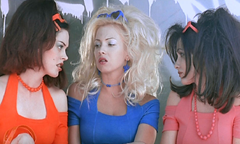


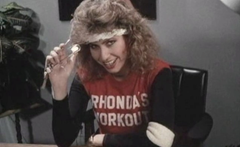




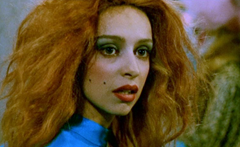

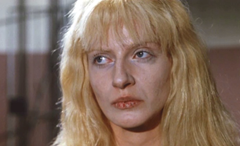








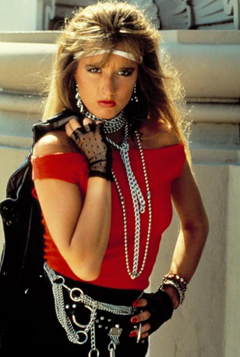




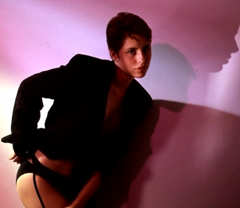


















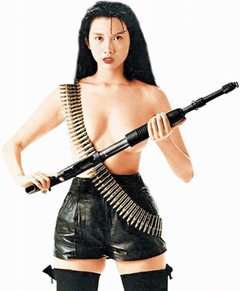
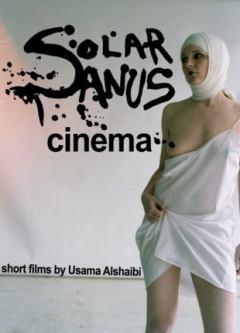
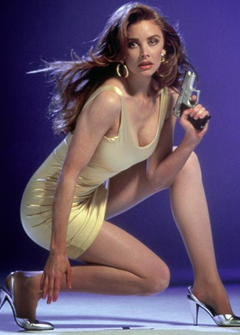
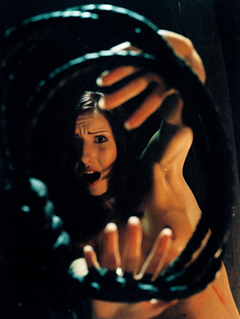
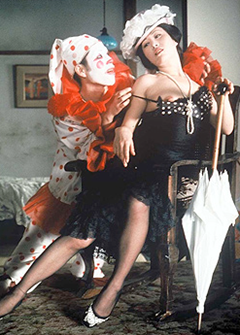
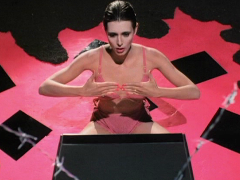
No comments:
Post a Comment